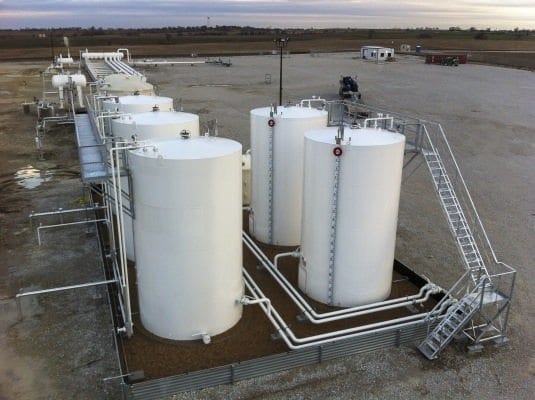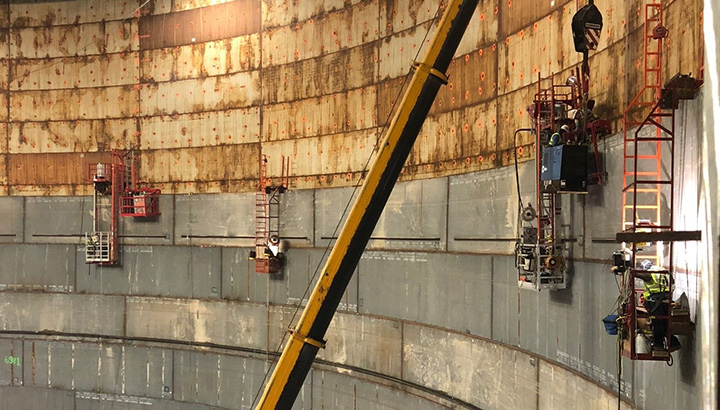Step-by-Step Overview of API 650 Welding Inspection Methods and Instruments
Wiki Article
How Welding Assessment Works: A Comprehensive Overview for Professionals
Welding evaluation plays a vital function in guaranteeing the safety and security and dependability of bonded structures. It includes a systematic method that consists of both visual assessment and progressed testing techniques. Specialists should acquaint themselves with vital criteria and guidelines controling the industry. Comprehending the usual defects that can occur throughout welding is essential. This guide will discover these components thoroughly, offering understandings right into the procedures that promote quality and stability in welding.Recognizing the Relevance of Welding Inspection
While lots of might undervalue the significance of welding evaluation, it plays a necessary duty in ensuring the honesty and safety of bonded structures. Effective welding inspection determines possible defects and defects that can jeopardize structural strength and lead to devastating failures. The assessment procedure includes various techniques, such as aesthetic assessments, ultrasonic screening, and radiographic assessments, each contributing to the total analysis of weld quality.
Along with securing the architectural integrity, welding evaluation assures compliance with sector criteria and client specifications. By ensuring that welds fulfill called for tolerances and characteristics, evaluations help keep the dependability and longevity of elements in various applications, from building and construction to aerospace. Additionally, an extensive inspection procedure fosters a society of high quality and liability amongst welders and producers. Ultimately, welding examination is not merely a step-by-step step; it is an essential method that underpins the safety and security and performance of crafted systems throughout diverse markets.
Key Specifications and Rules in Welding Evaluation
The foundation of efficient welding inspection hinges on adherence to developed guidelines and standards. Various organizations, such as the American Welding Culture (AWS) and the American National Standards Institute (ANSI), stated standards that guarantee high quality and safety and security in welding practices. Secret criteria, such as AWS D1.1 for structural welding and ASME Section IX for pressure vessels, supply comprehensive requirements for welding procedures, assessments, and credentials. Regulatory structures, consisting of those from the Occupational Safety And Security and Health Administration (OSHA), mandate safety practices and worker protections in welding environments. Conformity with these criteria is essential for attaining regular weld quality and reducing the danger of failures. Furthermore, global standards like ISO 3834 further enhance international uniformity in welding assessment methods. Professionals must remain educated regarding these policies to assure that their examination methods straighten with sector expectations and legal needs, consequently protecting both personnel and architectural stability.Initial Prep Work and Visual Inspection Techniques

Efficient welding evaluation starts with an extensive pre-inspection list that guarantees all needed conditions are satisfied prior to the real evaluation takes area. Following this preparation, visual issue recognition plays an important duty in evaluating weld high quality, allowing examiners to detect issues such as fractures or inappropriate combination. With each other, these methods develop the structure for an effective welding evaluation process.
Pre-Inspection List
Prior to starting any welding assessment, a thorough pre-inspection checklist is vital to assure that all necessary preparations are completed which aesthetic assessment strategies are properly employed. Crucial element of this checklist include confirming the welding procedure spec (WPS), ensuring all tools is adjusted and in great functioning problem, and validating that the assessor has the needed qualifications. In addition, it is vital to review any previous inspection reports and to assess the workplace for safety hazards. The inspector should additionally validate that all appropriate paperwork, such as material certificates and inspection documents, is conveniently offered. Completing this checklist aids to establish a strong structure for an effective inspection process, enhancing the reliability of the outcomes acquired.Aesthetic Defect Identification
A successful aesthetic problem identification procedure begins with mindful preliminary preparation and the application of well-known visual inspection strategies. Inspectors need to ensure that the welding location is well-lit and tidy, as appropriate visibility is crucial for identifying problems. A comprehensive exam of the weld joint's surface enables the identification of stoppages, such as fractures, damages, or porosity. Inspectors commonly utilize tools like multiplying glasses or mirrors to enhance their sight of hard-to-reach locations. Additionally, they must know with the specific welding requirements and standards relevant to the task. By sticking to these methods, examiners can properly identify prospective problems, guarding the integrity of the weld and compliance with market criteria.Non-Destructive Screening Methods: A Summary
Non-destructive testing (NDT) techniques play a crucial role in the welding assessment procedure by making certain the integrity and reliability of bonded structures without creating any damage (API 650 Welding Inspection). These strategies allow inspectors to assess the high quality of welds while protecting the parts being checked out. Common NDT methods include ultrasonic testing, radiographic screening, magnetic particle testing, and dye penetrant testing, each offering special advantagesUltrasonic testing utilizes high-frequency sound waves to discover interior problems, while radiographic testing uses X-rays or gamma rays to imagine the interior structure of welds. Magnetic particle screening discloses surface area and near-surface flaws by applying a magnetic area and iron bits to the weld location. Dye penetrant testing highlights surface-breaking flaws through the application of a tinted color. Together, these NDT methods provide critical insights right into weld high quality, allowing professionals to make informed choices pertaining to security and compliance in welding applications.
Usual Issues and Their Implications
Recognizing usual problems in bonded joints is necessary for keeping architectural integrity and safety. Various defects can emerge throughout the welding process, each lugging prospective implications for the total performance of the framework. Porosity, defined by tiny gas pockets within the weld, can deteriorate the joint and compromise its load-bearing ability. Cracks might establish due to thermal anxiety or improper air conditioning, resulting in potential failure under stress and anxiety. Incomplete blend happens when the weld steel does not fully bond with the base product, resulting in weak joints that may not hold up against designated lots. Undercutting, where the base steel is eroded, can likewise lower the effective cross-section of the weld. In addition, excessive reinforcement can develop stress focus that can result in failing. Recognizing these problems without delay enables restorative actions, guaranteeing the long life and reliability of welded structures in vital applications.Devices and Tools Utilized in Welding Inspection
Effective welding assessment counts on a variety of specialized tools and equipment to guarantee the high quality and stability of bonded joints. Essential instruments include aesthetic examination devices, such as site link multiplying glasses and borescopes, which allow examiners to carefully take a look at welds for surface area issues. Non-destructive screening (NDT) approaches, such as ultrasonic screening, radiographic screening, and magnetic fragment screening, are basic for recognizing inner imperfections without harming the product.Dimension tools, including calipers and weld gauges, help identify and assess dimensions compliance with requirements. In addition, solidity testers review the mechanical homes of welded joints. Personal safety tools (PPE) is likewise critical, this securing the safety and security of assessors while working in potentially unsafe settings (API 650 Welding Inspection). Each tool serves a details purpose, collectively boosting the efficiency of welding evaluation and adding to the reliability of finished jobs
Regularly Asked Questions
What Certifications Are Required to End Up Being a Welding Inspector?
To come to be a welding inspector, individuals normally need relevant qualifications, such as AWS CWI or CSWIP, together with experience in welding processes, design principles, and expertise of assessment techniques, safety and security requirements, and applicable codes.Just How Commonly Should Welding Inspections Be Carried Out?
Welding inspections must be conducted regularly, preferably at different task stages, including pre-weld, during-weld, and post-weld. Regularity might likewise rely on market criteria, project specs, and the complexity of the welds involved.Can Welding Defects Be Repaired After Assessment?

Yes, welding defects can frequently be fixed after examination. Depending upon the severity and sort of defect, suitable techniques such as remodeling or additional welding might be employed to restore architectural stability and safety compliance.
What Industries Require Normal Welding Examinations?

Various industries, consisting of construction, manufacturing, aerospace, and vehicle, call for normal welding examinations - API 650 Welding Inspection. These inspections assure adherence to safety and security criteria and quality assurance, decreasing threats connected with architectural stability and operational efficiency in bonded parts
Just how Do I Select a Welding Assessment Service?
To click this link choose a welding inspection solution, one must think about certifications, experience, certifications, and sector track record. In addition, examining customer testimonials and ensuring the service fulfills appropriate standards can aid ensure top quality examinations and trustworthy results.
While several might underestimate the relevance of welding inspection, it plays a necessary role in making sure the integrity and security of bonded frameworks. Key requirements, such as AWS D1.1 for architectural welding and ASME Area IX for stress vessels, supply extensive criteria for welding procedures, examinations, and qualifications. Effective welding assessment starts with a thorough pre-inspection checklist that assures all essential problems are met before the actual evaluation takes location. Before beginning any type of welding assessment, a detailed pre-inspection list is essential to guarantee that all necessary preparations are finished and that aesthetic examination strategies are properly used. Non-destructive screening (NDT) techniques play a necessary duty in the welding examination procedure by making certain the stability and dependability of welded structures without causing any kind of damages.
Report this wiki page